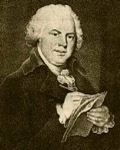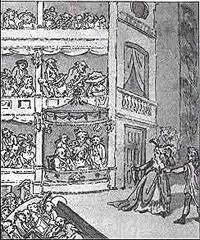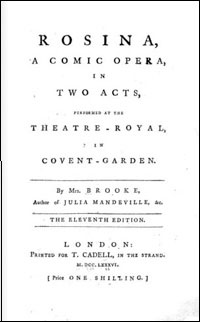|
|
|||

|
| broadsides |
| charles avison |
| robert ord |
| sixstring |
| school |
|
|

|
| william shield |
| his music |
|
|
| links & email |
|
|
|||

|
|
Operas
Possibly the most profitable and performed afterpieces at the Haymarket Theatre. Shield mixed the military slant of the libretto with appropriate rhythms contrasting nicely with the numerous pastoral and romantic pieces in 6/8 time. 1782 Rosina Shields most often performed work with over 200 London performances by 1800. It also follows the same blend of borrowed traditional music with original music by Shield. After Robert Burn's death a folk melody in the overture played by the oboe and bassoons imitating the bagpipe was revised and used to Burn's poem "Auld Lang Syne". Broadsides has realised an orchestral version of the Overture to Rosina from a marked piano score which may be seen and heard.
The first of Shield's collaborations with the Irishman O'Keeffe who claimed that he sang tunes that he recalled from his childhood so that Shield could use them to give the opera its Irish flavour. 1785 Omai This was a fantasy version of the late Captain Cook's voyage to the Pacific Ocean. 1786 Love in a Camp Shield's works with the Irishman O'Keeffe produced many Celtic works showing his ability to score accompaniments to this type of music without losing its character. 1787 The Farmer The second of Shield's collaborations with O'Keeffe. The well known song "The Ploughboy" comes from this opera. 1788 The Highland Reel This opera followed the publication of Boswell's journal of a tour to the Hebrides in 1786. 1790 The Crusade In this opera Turkish rhythms were used, because Turkey had sent its first ambassador to London that year. 1790 The Czar A comic opera about Peter the Great. 1791 The Woodman Seen by Haydn on the 10th of December 1791. Shield was paid a £1000 for the score, his last major successful opera. 1795 The Mysteries of the Castle A Sicilian gothic opera. 1796 The Lad of the Hills The last of Shield's collaborations with O'Keeffe. Unfortunately most of William Shield's orchestrations are lost and only piano accompaniments to his songs survive to this day. Songs William Shield wrote many popular songs notably "The Milkmaid" and "The Ploughboy", Hummel wrote a set of variations for the piano based upon the tune of "The Ploughboy". Chamber Works Shield's string trios were published, and it said that Shield's friend Haydn performed alongside him in the performance of one of these. Always experimenting with rhythms and extraordinary times, two of the movements in this set of trios were in 5/4 time, and thus, he is probably the first composer to write in this timimg. |

|
 1778 The Flitch of Bacon
1778 The Flitch of Bacon
 1783 The Poor Soldier
1783 The Poor Soldier